Armenia’s property market at a standstill
Armenia is a small Christian country (it was the first country in the world to adopt Christianity as its official religion) which lies high in the mountains of Ararat, mostly surrounded by Muslim neighbours (between 1 million to 1.5 million of the Armenian population of Turkey was killed in the Armenian genocide of 1915-17). It has the oldest Christian Church, and the world's oldest wine industry. Proportionately speaking the Armenian diaspora is enormous, with 8 million Armenians worldwide living outside the country, compared to a home population of around 3 million.
In 1990 it was the first non-Baltic republic to secede from the Soviet Union, and now has a completely free-market economy. It is poor (GDP of $3,535 per capita in 2015). It has an ongoing conflict with neighboring Azerbaijan, because of the large population of Armenian Christians in Nagorno-Karabakh.
Though it is mountainous and beautiful, it is remote and very hot in summer, but very cold in winter, so it attracts little tourism.
Armenia's property market
Armenia's property market has not recovered from the 2008 housing slump, despite robust economic growth. Demand remains depressed.
During the year to Q1 2016, the average residential property price in Armenia rose a meagre 0.1% to AMD 184,500 (US$389) per square meter (sq. m.), according to the State Committee of the Real Estate Cadastre.
In Q1 2016:
- The average price of apartments in the country increased by 0.3% y-o-y to AMD 180,600 (US$ 381) per sq. m.
- The average price of private houses in Armenia was unchanged from a year earlier, to AMD 188,300 (US$397) per sq. m.
Foreigners may only lease land for up to 99 years. However, foreign individuals are allowed to purchase a house in Armenia, and a company registered by a foreigner in Armenia as an Armenian business entity has the right to buy land.
A major group of buyers are Syrian Armenians, according to local real estate experts. "Many came and rented apartments for a month, and they now extend their rents for another month after hearing news of the worsening situation in Syria. People are scared," said Garik Danielian, a private real estate agency owner in Yerevan. There is also a small Yazidi community in Armenia.
From boom to bust
Armenia experienced a great housing boom from 2004 to 2008. House prices soared by about 250% over the four year period, based on the International Monetary Fund (IMF) report Armenia's Housing Boom-Bust Cycle. In Yerevan the house price to income ratio peaked at 16.5 in 2007, and the house price to rent ratio peaked at 28 in 2008.
Real estate construction increased four-fold during this period. The construction sector grew exponentially, its share of GDP increasing from 10% in 2000, to 25% in 2008.
In the wake of the global financial crisis, construction collapsed to a third of 2008 peak levels. Property transactions plummeted by almost 30%. House prices fell by 15%.
The housing market has not yet fully recovered since then. In Yerevan, the capital, the average apartment price increased by only 0.2% to AMD 274,600 (US$ 579) per sq. m. in Q1 2016 from a year earlier, while private house prices were unchanged at AMD287,000 (US$605) per sq. m.
In the regions, apartment prices rose by 0.4% y-o-y to an average of AMD 86,600 (US$182) per sq. m. while private house prices increased 0.2% to AMD 89,900 (US$189) per sq. m.
Demand remains depressed. Real estate transactions in Armenia dropped 15.5% in 2015 from a year earlier, to 180,944 units, according to State Committee of the Real Estate Cadastre. Yerevan accounted from 34.4% of the total transactions. Around 28% (50,023 units) of the total real estate transactions were alienation deals, of which 72.8% are purchase and sale transactions.
Armenia's real estate market is expected to continue to stagnate for at least two more years, according to Marina Chatinyan of Bars Real Estate Agency. This is mainly due to the adverse effects of global political and economic conditions, and slowing economies of Armenia's trading partners, especially Russia.
"Real estate operators and the processional actors in the market are waiting for the market to reach the minimum, the bottom, after which a slow, gradually increase may be possible," Chatinyan said.
Armenia's economy is expected to expand by 2.2% this year, down from a growth rate of 3% last year and the lowest growth rate since 2010, according to the International Monetary Fund (IMF).
Local house price variations
The Centre community has the most expensive residential property market in Yerevan, with an average apartment price of AMD 428,000 (US$902) per sq. m. and an average private house price of AMD 476,100 (US$1,003) per sq. m. in Q1 2016.
In contrast, the Nubarashen community has the capital's cheapest housing with an average apartment price of just AMD 157,100 (US$331) per sq. m. and an average house price of AMD 150,800 (US$318) per sq. m..
In the regions, the resort town of Tsakhkadzor in Kotayk region had the highest residential property prices, with an average price of AMD 292,400 (US$616) per sq. m. in 2015, down slightly from a year earlier. The average price of private houses in the region was AMD 305,000 (US$643) per sq. m. last year, unchanged from the previous year.
Dastakert in Syunik region had the lowest residential property prices in Armenia. The average price of apartments and private houses in the region was unchanged in 2015 from the previous year, AMD 8,000 (17) per sq. m. and AMD 11,600 (US$ 24) per sq. m. in 2015, respectively.
Apartments in the center of Yerevan and in the prime resort of Lake Sevan have seen the greatest demand in recent years. Gyumri and Vanadzor are also increasingly becoming popular.
Transactions remain depressed
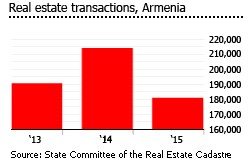
Real estate transactions in Armenia dropped 15.5% in 2015 from a year earlier, to 180,944 units, according to State Committee of the Real Estate Cadastre. Purchase and sale of apartments and private houses dropped by 14.7% and 17.4%, respectively. Yerevan accounted from 34.4% of the total transactions last year.
Construction activity remains down
Slowing construction is one reason the property market has slowed, according to Hakob Baghdasaryan, head of Akcern real estate agency.
In February 2016, individually-funded construction dropped 11.3% to AMD 2.06 billion (US$ 4.33 million) from the same period last year, according to the National Statistical Service (NSS). Individually-funded construction accounted for 16.8% of total construction during the period.
The construction boom during 2004 to 2008 was largely undertaken by households, not developers. Property developers accounted for only 22% of total construction, financing themselves by presales with deferred payments.
Small mortgage market
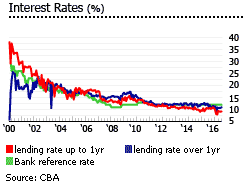
Armenia's mortgage is very small, despite recent growth. From just 0.5% of GDP in 2005, the mortgage market grew to about 3.55% of GDP in 2015, according to the Central Bank of Armenia (CBA).
In July 2016, total mortgage loans rose 4.1% year-on-year to AMD179.85 billion (US$378.9 million), according to the CBA.
- Dram-denominated mortgage loans, which accounted for 46.5% of total mortgage loans, increased 9.9% y-o-y in July 2016, to AMD 83.6 billion (US$176.2 million).
- Dollar-denominated mortgage loans, which accounted for 53.5% of the total, dropped 0.5% y-o-y in July 2016, to AMD 96.2 billion (US$202.7 million).
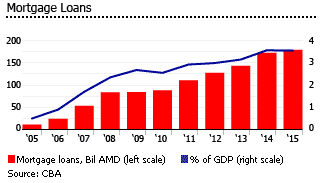
Economic growth is modest
From 2001 to 2007, Armenia experienced spectacular economic growth, with an average GDP growth rate of 12.8%. However growth slowed sharply to 6.9% in 2008, then the economy contracted by 14.15% in 2009. The economy bounced back in 2010, with a growth of 2.2%. In 2012, the economy expanded by 7.2% after growing by 4.7% in the previous year.
In 2015, the economy expanded by 3%, from annual growth rates of 3.5% in 2014, 3.3% in 2013, 7.1% in 2012, 4.7% in 2011, and 2.2% in 2010, according to the IMF. The economy is projected to grow by a modest 2.2% this year.
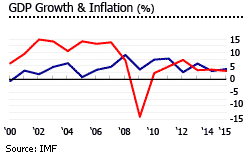
Armenia recorded a government budget deficit of 4.8% last year, up from 1.9% in 2014 and the biggest deficit since 2010, according to the CBA.
The 2016 state budget projects a deficit of 3.5% of GDP.
Armenia's government debt was equivalent to 42.23% of GDP in 2015, according to the CBA. In 2016, debt is projected to rise further to 49.4% of GDP, while foreign debt is expected to be equivalent to 42.8% of GDP.
"Affordable Housing for Young Families" program
Introduced in January 2010, the "Affordable Housing for Young Families" program aims to help young families purchase their first homes. During its first year, about 300 families benefitted from the program.
Housing loans under the program stood at AMD 54.1 billion (US$111.7 million) by January 1, 2016.
Recent amendments to the program are expected to boost the housing market:
- The maximum age limit of potential beneficiaries was increased to 18-35, from the previous 18-30. The total age of the couples is raised to a maximum of 65 years, from 60 years.
- The maximum value of houses that can qualify under the program was raised to AMD 25 million (US$52,675), from AMD 16 million (US$33,712)
- The maximum amount of housing loans under the program was increased to AMD 17.5 million (US$ 36,873), instead of the current AMD 11.2 million (US$ 23,598)
- The minimum down payment in Yerevan was reduced to 10% of the total cost, instead of the previous 20% to 30%.
Interest rates for these housing loans range from 8% to 9% in Yerevan and from 6% to 7% in the regions.
Deflation and high unemployment
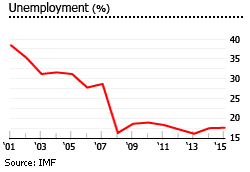
In July 2016, consumer prices fell by 1.3% from a year earlier - the six consecutive month of falling prices.
In an effort to fight deflation, the central bank cut its refinancing rate in August 2016, to 7.25%. However, the high dollarization of the country's banking sector, with more than 60% of deposits are denominated in dollars, undermines the efficacy of the central bank's monetary policy, according to Fitch Ratings.
Unemployment stood at 17.7% in 2015, unchanged from the average unemployment rate of 17.6% from 2008 to 2014, according to the IMF, and a significant improvement on the average jobless rate of 32% which prevailed from 2001 to 2007.
is expected to increase further to 18.2% this year, and to 18.3% in 2017.
Political crisis and corruption
Corruption remains a major concern in Armenia. In July 2016, a radical armed group seized and held a police station in Yerevan for two weeks, marking the country's worst political crisis in eight years. Two policemen were killed before they eventually surrendered. The roots of the crisis lay in the failure of the government to tackle corruption, unemployment, emigration, and a political culture of impunity.
During the 2013 presidential elections, incumbent president Serzh Sargsyan won reelection with 59% of the vote. However, second-runner Raffi Hovannisian, with 37% of the vote, alleged electoral fraud.
Mass protests took place. Hovannisian, together with his supporters, started a hunger strike in Freedom Square. However on 14 March 2013, the Constitutional Court of Armenia confirmed the victory of President Sargsyan. Despite this, many continue to question President Sargsyan's legitimacy up to this day, and have accused him of failing to improve the lives of Armenians.
Armenia is also in conflict with its neighbours. Two important neighbours, Azerbaijan and Turkey, have closed their borders to Armenia for political reasons. Azerbaijan and Armenia have not yet reached a peaceful resolution of claims on Nagorno-Karabakh, an area assigned to Soviet Azerbaijan in the 1920s by Moscow.
A ceasefire, in place since 1994, has failed to deliver any lasting solution. In fact, the territorial dispute is escalating further amidst a weapons build-up between the two nations.